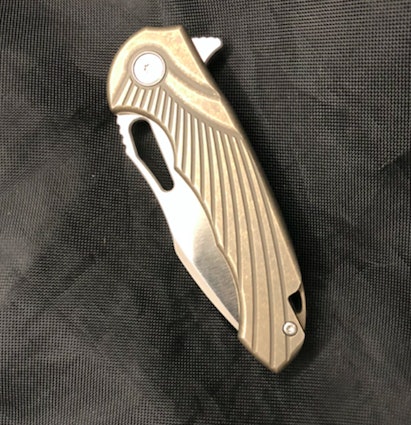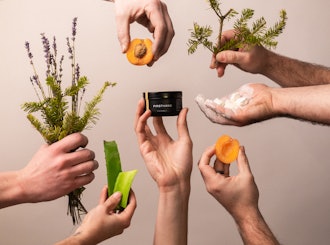Click to view our Accessibility Statement or contact us with accessibility-related questions






















Hi, We're Ferrum Forge Knife Works

search
close
Sort by: Newest
keyboard_arrow_down
SHAR1
9
Jun 26, 2019
Please I am a leftie who loves knives amd am constantly limited, Im sure cost wise its not much to be able to flip the clip so you can invite lefties to enjoy your beautiful pieces of art. Im on a mission to bring more awareness, that lefties enjoy spending money too. I myself am a great P.R. person for any company that includes ln lefties. I go out of my way to announce knives that work for me. Thanks for listening.
Heath333
0
Feb 21, 2019
Just recently became a knife collector, and came across your Instagram and started following you because of your amazing knives. Now I'm a Massdrop subscriber and can't wait to own a few of your knives. Love your guys work!
Scot.Spellman
7
Aug 31, 2018

stoutdog
305
Aug 24, 2018
Droogs53I like my Falcon a lot. The grip, whether using the choil/spine/grip or just the grip is very comfortable. It is about the minimum size for EDC and my preferred size. Beautiful design and WE carried out the construction superbly.
Scot.Spellman
7
Aug 31, 2018
stoutdogFortis 2.0 has a very similar design, but much larger, I dig em both.

mysticbulldog
2
Jul 19, 2018
i was very surprised after getting my Falcon in mail call, found it a bit small for my taste but the design of the knife was absolute, with the addition of the milled wings on the flat side my ownlywish it that they create a much larger flacon; maybe one with a 4+ inch blade

HudaNibs
20
Apr 23, 2018
Can we please, pretty please get lefty versions for left handers. We are left out and forgotten about. Thanx for the great knives you guys are crankin out!
higherstandard617
0
Mar 28, 2019
HudaNibsYes left handed Please. Im right handed, but i prefer knives on the left, drill with the left, play hockey with the left, etc... I believe there are a handful of either ambidextrous, or right handed people who would agree with me, I know a few in the trades that work their left comfortably like me, as well as a lot of kids on high school hockey team were right handed but played left. Even if you just make a ambidextrous knife, in which the clip can be moved to the other side,

Lieutenant
4
Apr 23, 2018
I am waiting on a four inch as in 4" blade that is styled like a BAK, Mordax, or Ferox. I just like a longer blade what can I say. The knives that you guys have done on Massdrop so far have looked great!!!

Ares78
1509
Keyboard Club Member
Jan 19, 2018
Is there a reason why you guys chose a blasted finish (for the handle) over say a satin or anodized finish?
Omniseed
1972
Feb 7, 2018
Ares78I think the handle feels chalky and almost bad at first, but after a month or two of handling it feels great
G3oc3ntr1c
7
Jan 18, 2018
I love mine, i'll be a life time buyer of FF. I'll save up and pay for a real one at some point but these WE produced FF designed knives are amazing for the price. I have a falcon and carry it daily and i will receive my Gent here very soon according it my emails from MD
Showing 18 of 48
Related Posts

Kretah
Waterproof GooseFeet Gear Over-Booties
So it seems that keeping your feet warm during cold camping trips just became both easier and more expensive. These over-booties are designed to cover down-socks if, for example, you have to pee in the woods at 3am. I can see the convenience of using GooseFeet Gear over-booties, but what do you guys think about the expense? So around $160 (depending on the shoe size) gets you both warmth and convenience. I guess it's worth it if you camp in the cold frequently or especially if you take expeditions in frigid regions. But then again, maybe I'm only saying that because I haven't (yet) ruined a pair of $69 booties for a midnight run. At least it's made in the USA.
Oct 9, 2020
pharaonis
Review: Graf von Faber-Castell Burned Orange
Hi everybody! I'm Conrad, a stationery lover and quiet lurker of the Massdrop writing community. I'm sure most of you definitely do not know me! But I'm super happy to meet you, and I wanted to invite you to maybe sit down a little while with me while we talk about the things we love: writing instruments and the things we buy to keep them chugging. Thanks to Mike, I was generously sent a couple of bottles of ink and I've been playing around with them for a little while. I think I'm about ready to share my thoughts on these inks over the next week or so; I hope you enjoy the review! I thought I would get us all started with an ink brand that I've actually never tried before: Faber-Castell! You probably know them for their other art products, like colored pencils and PITT artist brush pens. I certainly had no idea that they made inks. I have seen their fountain pens (I've heard they write particularly well right out of the box, although I've never personally tried...
Oct 3, 2017

XiK
The Relaunch of Firsthand Supply!
Hey friends, We're very excited to announce the very first product line from Firsthand Supply's rebrand! FHS has been a great partner for us for the past few years, we're so happy for their recent relaunch/remake of a classic community favorite. I want to share some of the rebranding and production convos we've had with FH: MD: Tell us about the new Firsthand Supply! FH: We are building a company that values people on both sides of the transaction. From how we source the ingredients and materials used in our products to our commitment to closed loop sustainable practices; everything we say, do, and make supports that truth. In our pursuit to create the best hair products on the globe, our aim is to become the most human-centric consumer brand through honest sourcing, sustainable process, and a heavy dose of give-a-damn. Why? Because we believe people matter, so we make stuff that matters. #MadeWithYouInMind MD: What is the major difference in the new packaging...
Feb 7, 2019

watchesofusa
Powered by Ameriquartz... the Brillier ‘Americana’ Chapter 3 watches
Powered by AMERIQUARTZ movements (Built Better in the USA ) the Brillier ‘Americana’ Chapter 3 Timepieces just announced the launch of their “Infantry” and “Air Wing” editions. These retro styled watches are a tribute to the brave American men and women that won the Second World War. The robust, all metal movements,which are built in Fountain Hills , Arizona, incorporate highly precise advanced American technology components in their assembly. With the advent of these quartz movements from FTSUSA, there is no doubt that the timepieces powered by Ameriquartz modules will enjoy a very long life span. These metal movements can be repaired easily if a fault develops over the years. Availability of spare parts and serviceability make these quartz movements indestructible. The low consumption design provides longer battery life. The Americana Collection from Brillier Watch Company, USA, is keeping its commitment of increasing American built components in their watches with each chapter...
Apr 30, 2020

napogloves
Ethiopian Lambskin Touchscreen Driving Gloves
LIVE DROP HERE: https://www.massdrop.com/buy/napo-mens-touch-screen-driving-gloves
Aug 14, 2018

Anent
Wolverine's 1000 Mile Boot
Curious about experiences with this classic. Cautious to order online if the fit isn't great...though it seems they can be returned within 45 days (except for custom boots). Fit: Online comments suggest ordering a size 10, for example, rather than 10.5 (as a typical ideal fit). How about width? Is a standard D actually D width or slightly narrower or wider? D and 3E seem to be the only width options. Models: So many.... Any advice/preferences/etc. in picking the style? An attempt at summarizing *boot* style variations: Original -- including a leather sole... Evans -- grippy sole, otherwise original style? Addison Wingtip -- fanciest? Rockford Cap-toe -- fancier... Harwell Chukka -- lower cut & fancier... Montague Chelsea -- slip-ons & grippy sole Courtland -- grippy sole & boxier toe?? 'Cortado' -- full Vibram sole I'll likely go for the Original, though the Evans is also appealing. Are leather or rubber soles 'better'? Color: How do the various color options wear...
Nov 1, 2017
Trending Posts in More Community Picks

Graham88
Completely surprised by the lack of blade diversity here on Drop...
I’ve been a collector of Blades since before my teens, and a retailer coming up on 15… or maybe 20 years. Drop has really been kind of an interesting experience for me, because I do occasionally get to see some unusual tech and sometimes EDC items that otherwise I might not have been aware of. And maybe it’s because I have a deep love of cutlery and bladed weapons, but I find myself trolling through the site looking at it what’s available; and it’s just it’s pretty much the same. And the bladed community here is just always confused me.. every single knife is about the same, they’re almost all drop points and although the handle materials change and brands change.. it’s really just the same knife over and over and over again... occasionally you’ll see a tanto or a slight variant; but rarely… and almost never a serrated blade. And I’m just deeply amazed at this diversion of serrated blades. And I’m just surprised there isn’t more of a request for diversity here.... and I...
Mar 12, 2020
JellyDPhoto
Can we get Sony E-Mount or other mirrorless camera options please..
Would be nice to see some Sony E mount full frame cameras on here. I currently shoot with a A99 and they killed the lense path for better or more option lenses and now is all E-Mount. 🤔
Jan 13, 2020
RayF
There Are Pandas, and Then There Are Pandas.
And this isn't either of them! The Pandas we're talking about here, are watches, not bears. And what got me thinking about them (again) was a link posted this morning by @cm.rook who pointed a few of us to the very attractive (and not terribly priced) Yema "Rallygraph" Panda which, in it's most traditional arrangement, looks like the one on the left, but can also be had in the version on the right: The model on the left is a true Panda, while the model on the right is called a reverse Panda. The reason for that distinction is clear--Panda bears, only come in the first arrangement. Now at this point, everyone should be thinking about the most well-know Panda, The Rolex Panda, which is actually a Daytona, and among Rolex Daytonas, the most famous of which is the Paul Newman Daytona, which was famous first, because it was Paul's, and second because it sold at auction for $17.8 million (US Dollars). The story of that auction is well-known so I'll only...
Nov 8, 2019








Chris: Hey everyone, I’m Chris Williamson, CFO and what I like to call the Conscience. He’s a creative guy, but some of his ideas can be a bit “out there”. Every artist needs an editor.
Elliot: That is actually true! But that’s not the whole story of what we do around here. Since there are only two of us here, we do everything and we mean - everything. We might be the only executives that still have to clean the bathroom. While I do the heavy lifting of the designing, engineering, and planning for our knife runs, Chris evaluates and approves what I come up with - since we both build our knives. Plus Chris is in charge of writing the checks so he has to keep me grounded in the real world.
Chris: The struggle is real, but the balance of Elliot’s creativity and imagination and my logistical awareness have created something greater than just the two of us making knives together.
Elliot: To give you an idea of what Chris means we should probably tell you a little bit about our story, because you kind of have to know where we came from in order see where we’re going as a company and how this partnership with Massdrop and WE Knife Co. came to be and why it’s pretty special. This all starts years ago in the days of our youth with our Grandfather. Like most men from his generation, he carried and used a knife everyday. At the age of 4 he made sure that Chris and I had our very own knives, but taught us how to respect a tool and use it safely. Years later, with my knife addiction at full power, my tastes in knives started getting more and more expensive. This got me wondering about why knives cost what they do and I did what I do best and started researching why some knives can get up over $1000. And that’s when I found out about custom knives and my eyes were opened. I consider myself a crafty fella and figured if people have been making edged tool for thousands of years, I can make one in my garage. Over the years I got pretty good at building and fixing things, partially because I break everything and partially due to the influence of our father, who was actually a professional baseball player, but was going to college to get an Engineering degree before he was drafted by the San Diego Padres. After baseball he took his mechanical engineering background and applied it to crafting custom furniture and cabinets.
Chris: He actually took one of the drops from waterjet and built a coffee table to fit the piece of steel as the table top, it’s in my apartment and everyone that sees it marvels at it.
Chris: Yeah he tried… they were, um, rustic looking knives. Some might even say prison shank-ish.
Elliot: Now don’t get me wrong, pounding a hot piece of steel into shape has a certain joy to it, but it was very time consuming, very loud (especially in a residential neighborhood), very hot, and did i mention very time consuming? Ferrum Forge was named during my early forging days and is still a reminder of where we came from and how much we’ve grown. It took about 6 months of forging steel to realize it is far from the best method of making a knife. Around that time I had my first large paradigm shift. I started collecting more grinding equipment and moved to stock removal rather than forging. Along the way i was devouring every bit of info about knives, metallurgy, material science and engineering from books and our favorite source of information, the internet. By 2012, I made my first folder and things started to change for my little hobby business.
Elliot: By the end of 2012 I had significant wait list for folders and back then I was doing something that was pretty unique even in the custom knife world. I would make whatever people wanted. I would often get a picture through email of a drawing on a napkin of something that looked kinda like a knife, and I would redraw it and eventually make it a real knife. This was a very educational process and I have made some things that were a little out there, but it was also a very long process and I certainly wasn’t able to sustain knife making with what I was charging for knives, and my prices were right around what we charge for a knife these days. In the beginning of 2013 the opportunity arose to move into this shop and I could not pass it up. So I started what I think of as the modern era of Ferrum Forge.
Chris: You can actually see all of this on our youtube channel. Elliot started making videos in early 2012. There are over 120 videos so it will take you some time to watch them all, but you can actually watch the evolution of Ferrum Forge over the years.
Elliot: I do have to warn you, they are not high quality videos, in fact, some are real bad, but it was what we had to work with. It was in 2013 that we went all in on a more modern mode of knife making and bought a CNC mill, I taught myself Computer Aided Design and Computer Aided Manufacturing software, we started having parts cut from sheets of steel and titanium by waterjet, and I taught myself how to run a CNC mill. It was huge learning experience and if I’m being really honest, it wasn’t a hugely successful endeavor. But it did lay the foundation for how we make knives now by teaching me, in very specific ways how to design knives to be machined with modern manufacturing methods and how to keep the machining cost low so we could offer knives at the prices we offer them at now. But even at as low a price as we can offer knives with level build quality and materials we do now, we have always know that our prices are still out of reach for most people.
Chris: The goal of that run was to offer a knife with the quality of a custom knife but at an attainable price. We’ve spent the last 4 years refining our process and attempting to minimize the cost of our knives and have been fairly successful, dropping the price from an average of $800 down to $500. Unfortunately to bring the price lower we had to look outside of our manufacturing avenues.
Here's some shots of the CAD render of the Falcon: